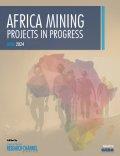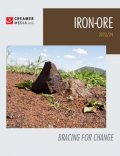|
SELECT a_id, a_id_word, a_headline, a_publish_date, a_abstract, a_author, a_has_video, a_has_audio FROM su_cat_sg_mappings, re_categories , re_category_sections_assoc , pr_sections , pr_article_section_assoc , pr_articles_search, pr_article_media_assoc WHERE csg_sg_id = 1 AND csg_cat_id = cat_id AND a_status = 1
AND a_process_status = 4 AND a_expiry_date >= 1719424800
AND cat_id = scat_cat_id AND scat_s_id = s_id AND s_id = ase_s_id AND ase_a_id = a_id
AND cat_re_id = 42 AND ama_a_id = a_id AND ama_mt_id = 2 AND ama_p_id = ase_p_id AND s_id NOT IN (14903,14910,14911,14906,14904,14912,14909,14908,14907,14905) AND a_publish_date <= 1719424800 AND ase_s_id IN (14576,15076,14885,15075,14270,14271,14272,14886,14274,14273,14888,15674,14887) GROUP BY a_id ORDER BY a_publish_date DESC LIMIT 0, 100
|
 |
Coal 2018: A review of South Africa's coal sector
 Published: 12 Oct 18
Despite concerns about greenhouse-gas emissions, coal – which is used to generate about 37% of the world’s electricity and plays a crucial role in industries such as iron and steel manufacture – will continue to be a significant energy source for decades to come.
South African coal producers are also benefiting, as strong demand from State-owned power utility Eskom and other local industrial customers competes against surging global demand. The commodity is the largest revenue generator in the country’s mining industry, earning about R131.40‑billion in 2017. It also contributes immensely to the fiscus in taxes and royalties and employs tens of thousands of people directly, with many more employed indirectly outside the sector.
Despite its importance, South Africa’s coal mining sector faces several constraints that might impact on its sustainability and growth. In its Coal Strategy 2018, Minerals Council South Africa – formally the Chamber of Mines of South Africa – identifies the policy and regulatory environment, inadequate infrastructure, difficulties in accessing capital and land, and the challenges posed by technological advances as potential constraints to the sector.
Creamer Media’s Coal 2018 report examines South Africa’s coal industry with regard to the business environment, the main participants, local demand, coal exports and coal logistics, projects being undertaken by the large and smaller participants, as well as various issues affecting the sector, including labour issues and environmental considerations.
|
Coal 2018: A review of South Africa's coal sector
|
 |
Gold 2018: A review of South Africa's gold sector
 Published: 04 Oct 18
South Africa’s gold production has plummeted 85% over the past four decades, with the country now ranked as the world’s eighth-biggest gold producer, according to information services firm Thomson Reuters’ GFMS Gold Survey 2018.
The country’s gold mines are the deepest in the world and their depleting orebodies are becoming increasingly difficult to extract. Coupled with deteriorating safety standards, owing to the depth and complexity of these mines, and compounded by regulatory issues, the volatile rand is creating significant headwinds for all the country’s gold producers.
To face some of these headwinds, local gold producers have been restrategising through the implementation of new technologies, while others downsize, cut lossmaking operations and/or strategise through acquisitions to cut costs and improve productivity.
Creamer Media’s Gold 2018 report reviews the South African gold market in this context, with a particular focus on supply, labour challenges, the class law suits that some of the country’s major gold miners are facing, safety issues and prospects for the market. It also reviews the major and smaller mining companies with operations in South Africa.
|
Gold 2018: A review of South Africa's gold sector
|
 |
Projects in Progress 2018 (Second Edition)
 Published: 04 Oct 18
Statistics South Africa’s report, titled “Capital expenditure by the public sector 2017”, held few surprises – especially happy ones – for practitioners in South Africa’s project economy. The report confirms that total capital expenditure (capex) by the 751 public-sector institutions that reported their capex figures to the agency decreased by R12.1-billion last year, from R283.3-billion in 2016 to R271.2-billion.
It was the first year-on-year public-sector capex decrease since the 2009/10 fiscal year – the period coinciding with South Africa’s financial-crisis-induced recession. The decline put to rest government’s previous narrative of public-sector expenditure providing countercyclical support for an economy still struggling to recover from the crisis.
The outlook is not covered in the report, but all signs point to a sustained period of downward pressure. Most of the State-owned companies (SOCs) are in financial distress, largely owing to years of weak management and corrupted governance, which facilitated a redirection of procurement budgets towards a predatory elite. The outlook is undermined further by most SOCs now having massive debt burdens to address and interest bills to manage.
What does this mean for gross fixed capital formation and the domestic project pipeline? It means that any recovery will have to be led by the private sector. However, to achieve such a shift, investor confidence will have to be restored and sustained.
Nevertheless, this second edition of the Projects in Progress for this year includes valuable updates on some of South Africa’s largest infrastructure projects, as well as ongoing investments in the gold, coal and platinum sectors.
|
Projects in Progress 2018 (Second Edition)
|
 |
Africa Mining Projects in Progress 2018 (Second Edition)
 Published: 24 Jul 18
Mining is one of Africa’s major export industries, with global affairs and evolving market conditions shaping the industry landscape. While Africa initially gained a reputation for its gold and diamond resources, the African mining industry is now also being recognised for its copper, cobalt, manganese and platinum group metals resources.
This edition of Creamer Media’s Africa Mining Projects in Progress highlights some of the prospective projects on the continent that have been announced in some of these sectors, focusing on recent preliminary economic assessments, scoping, prefeasibility and definitive/bankable feasibility studies, as well as some of the projects that are already under way.
|
Africa Mining Projects in Progress 2018 (Second Edition)
|
 |
Platinum 2018: A review of South Africa's platinum sector
 Published: 10 Jul 18
In what could be described as a lacklustre year for the platinum industry, 2017 saw platinum group metal prices plummeted in 2017, owing to a drop in gross demand, which fell by 2% to 8.17‑million ounces, leaving the market with a 250 000 oz supply surplus. South African producers have also faced the challenges of rising costs, regulatory uncertainties and safety stoppages, which have impacted on an already constrained global platinum market.
Creamer Media’s Platinum 2018 report provides a global overview of the platinum market, with a particular focus on South Africa’s platinum-sector business and regulatory environment. The report includes commentary on the main participants in South Africa’s platinum industry, other platinum producers, and exploration and development companies.
|
Platinum 2018: A review of South Africa's platinum sector
|
 |
Real Economy Insight 2018: Platinum
 Published: 29 Jun 18
Creamer Media’s Real Economy Year Book has been divided into separate reports under the banner Real Economy Insight, and investigates key developments in the automotive, construction, electricity, road and rail, steel, water, materials handling and logistics, pumps, coal, gold, iron-ore and platinum sectors.
This five-page brief is a synopsis of key developments in the platinum sector over the past 12 months, which includes platinum developments in South Africa, the country’s major producers, major mergers, employment concerns and the regulatory environment, as well as the outlook for the sector.
|
Real Economy Insight 2018: Platinum
|
 |
Real Economy Insight 2018: Iron-Ore
 Published: 29 Jun 18
Creamer Media’s Real Economy Year Book has been divided into separate reports under the banner Real Economy Insight, and investigates key developments in the automotive, construction, electricity, road and rail, steel, water, materials handling and logistics, pumps, coal, gold, iron-ore and platinum sectors.
This five-page brief is a synopsis of key developments in the iron-ore sector over the past 12 months, including details of the global and South African iron-ore markets, with a particular focus on supply and demand, iron-ore producers and their projects, as well as prospects for the sector.
|
Real Economy Insight 2018: Iron-Ore
|
 |
Real Economy Insight 2018: Gold
 Published: 29 Jun 18
Creamer Media’s Real Economy Year Book has been divided into separate reports under the banner Real Economy Insight, and investigates key developments in the automotive, construction, electricity, road and rail, steel, water, materials handling and logistics, pumps, coal, gold, iron-ore and platinum sectors.
This five-page brief is a synopsis of key developments in the gold sector over the past 12 months. It provides an overview of the global and South African gold market, including labour challenges, the silicosis class action law suits South Africa’s gold producers are facing, illegal mining, the gold price and outlook for the sector.
|
Real Economy Insight 2018: Gold
|
 |
Real Economy Insight 2018: Coal
 Published: 29 Jun 18
Creamer Media’s Real Economy Year Book has been divided into separate reports under the banner Real Economy Insight, and investigates key developments in the automotive, construction, electricity, road and rail, steel, water, materials handling and logistics, pumps, coal, gold, iron-ore and platinum sectors.
This five-page brief is a synopsis of key developments in the coal sector over the past 12 months. It provides an overview of the South African coal markets, corporate activity and the role of coal in South Africa’s electricity generation.
|
Real Economy Insight 2018: Coal
|
 |
Real Economy Year Book 2018
 Published: 29 Jun 18
During President Cyril Ramaphosa’s mea culpa social call on Desmond Tutu in May, the Archbishop Emeritus urged Ramaphosa to ensure that his much-vaunted ‘New Dawn’ did not turn out to be a ‘false dawn’.
Without doubt, all well-meaning South Africans share Tutu’s sentiments. The overwhelming majority of citizens, including those in business, are desperate to see South Africa succeed economically and increasingly yearn for a more just, caring and equitable, as well as safer, society.
Goodwill will be necessary, but insufficient to reignite growth- and job-stimulating investment. Trust and confidence remain fragile, and fresh uncertainty has also undoubtedly emerged as a result of the current debate about how best to proceed on much-needed land reform. It is up to government to take the lead in helping to rebuild greater resilience and confidence. The way it deals with the land debate will be a critical test, but so will its handling of issues as diverse as State-owned power utility Eskom’s sustainability, the next iteration of the Mining Charter and municipal competence. Without rapid and sustained progress across multiple fronts, Tutu’s warning of a false dawn could prove dreadfully prophetic.
This publication aims to make a contribution, however modest, to building a platform for greater economic dynamism, focusing on developments in the automotive, construction, electricity, road and rail, steel, water, materials handling and logistics, pumps, coal, gold, iron-ore and platinum sectors. These sectors do not only feature in this edition of Creamer Media’s Real Economy Yearbook, but as separate reports under the banner Real Economy Insight.
|
Real Economy Year Book 2018
|
|
|
 Buy Report
Just Energy Transition 2024: Investing in the future
Buy Report
Buy Report
Just Energy Transition 2024: Investing in the future
Buy Report
 Buy Report
Hydrogen 2024: Implementation crucial going forward
Buy Report
Buy Report
Hydrogen 2024: Implementation crucial going forward
Buy Report
 Buy Report
Roads, Rail & Ports 2024: Inefficiencies reach new lows
Buy Report
Buy Report
Roads, Rail & Ports 2024: Inefficiencies reach new lows
Buy Report
 Buy Report
Africa Mining Projects in Progress 2024
Buy Report
Buy Report
Africa Mining Projects in Progress 2024
Buy Report
 Buy Report
Iron-Ore 2023/24: Bracing for change
Buy Report
Buy Report
Iron-Ore 2023/24: Bracing for change
Buy Report
 Buy Report
Platinum Group Metals 2023: Crucial Element in the Energy Transition
Buy Report
Buy Report
Platinum Group Metals 2023: Crucial Element in the Energy Transition
Buy Report
 Riverstone Mall, South Africa
Published: 21 Jun 24
Riverstone Mall, South Africa
Published: 21 Jun 24
 SMR module development facility, UK
Published: 21 Jun 24
SMR module development facility, UK
Published: 21 Jun 24
 afrivolt 1 project, South Africa – update
Published: 21 Jun 24
afrivolt 1 project, South Africa – update
Published: 21 Jun 24


















